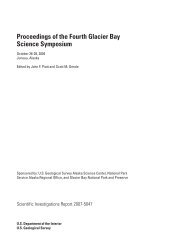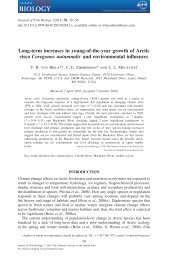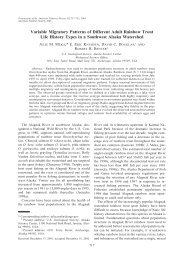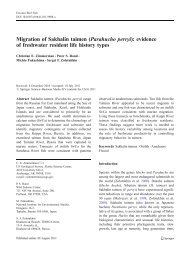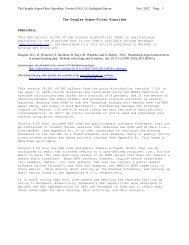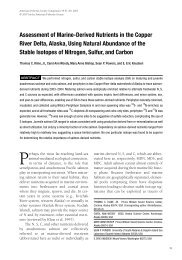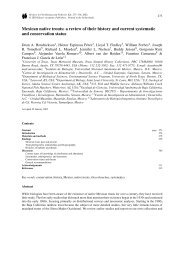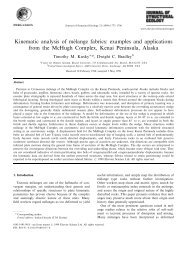Cook Inlet Seabird and Forage Fish Studies - Alaska Science Center
Cook Inlet Seabird and Forage Fish Studies - Alaska Science Center
Cook Inlet Seabird and Forage Fish Studies - Alaska Science Center
Create successful ePaper yourself
Turn your PDF publications into a flip-book with our unique Google optimized e-Paper software.
<strong>Cook</strong> <strong>Inlet</strong> <strong>Seabird</strong> <strong>and</strong> <strong>Forage</strong> <strong>Fish</strong> <strong>Studies</strong><br />
(CISeaFFS) Sisyphus News 1(1)<br />
Sisyphus News 1997 (1) p. 1<br />
PROJECT LEADERS<br />
John F. Piatt<br />
<strong>Alaska</strong> <strong>Science</strong> <strong>Center</strong><br />
Biological Resources Division<br />
U.S. Geological Survey<br />
1011 East Tudor Road<br />
Anchorage, AK 99503<br />
<strong>and</strong><br />
David G. Roseneau<br />
<strong>Alaska</strong> Maritime<br />
National Wildlife Refuge<br />
U.S. <strong>Fish</strong> <strong>and</strong> Wildlife Service<br />
2355 Kachemak Bay Drive<br />
Homer, AK 99603<br />
Ruth Anderson<br />
PARTNERS<br />
Exxon Valdez Oil<br />
Spill Trustee Council<br />
(APEX Projects<br />
97163-J,K,L,M,N<br />
97144, & 97306),<br />
U.S. Geological Survey,<br />
U.S. <strong>Fish</strong> <strong>and</strong><br />
Wildlife Service,<br />
U.S. Minerals Management<br />
Service,<br />
<strong>Alaska</strong> Dept. of <strong>Fish</strong><br />
<strong>and</strong> Game, National<br />
Marine <strong>Fish</strong>eries<br />
Service, University<br />
of <strong>Alaska</strong> Fairbanks<br />
It is difficult to assess the potential for recovery of<br />
seabirds from the Exxon Valdez oil spill (EVOS)<br />
<strong>and</strong> other human impacts (e.g., gill-nets, harvest,<br />
commercial fisheries, etc.) because long-term<br />
changes in the marine environment were apparently<br />
also affecting seabirds at the time of the spill,<br />
<strong>and</strong> during subsequent years. Since the late 1970’s,<br />
seabirds in the Gulf of <strong>Alaska</strong> have shown signs of<br />
food stress: population declines, decreased productivity,<br />
changes in diet, <strong>and</strong> large-scale die-offs.<br />
Small-mesh fishing trawls conducted during the<br />
past 30 years reveal that a major shift in fish community<br />
composition occurred in the late 1970’s:<br />
some forage species (e.g., capelin) virtually disappeared,<br />
while predatory fish (e.g., pollock) populations<br />
increased markedly. These changes correlate<br />
with long-term cycles in seawater temperature.<br />
It is not known whether fish communities will<br />
return to their previous composition <strong>and</strong> population<br />
levels.<br />
CISeaFFS (“Sisyphus”) was initiated in 1995<br />
as a long-term research project to characterize relationships<br />
between seabird population dynamics,<br />
foraging behavior, <strong>and</strong> forage fish densities in lower<br />
<strong>Cook</strong> <strong>Inlet</strong>— the area in which most seabirds were<br />
killed by the EVOS. CISeaFFS is a<br />
multidisciplinary research project of the <strong>Alaska</strong> <strong>Science</strong><br />
<strong>Center</strong> <strong>and</strong> the <strong>Alaska</strong> Maritime National<br />
Wildlife Refuge, which has management responsibility<br />
for most seabird colonies in <strong>Alaska</strong>.<br />
METHODS<br />
In 1995 <strong>and</strong> 1996, populations, productivity, diets<br />
<strong>and</strong> foraging behavior of seven seabird species<br />
(Common Murre, Black-legged Kittiwake, Pigeon<br />
Guillemot, Tufted Puffin, Horned Puffin, Pelagic<br />
Cormorant, Glaucous-winged Gull) were studied<br />
at three seabird colonies in lower <strong>Cook</strong> <strong>Inlet</strong><br />
(Chisik, Gull <strong>and</strong> Barren isl<strong>and</strong>s). Oceanographic<br />
measurements (SST’s, CTD’s), seabird transects<br />
<strong>and</strong> hydroacoustic surveys for fish, mid-water <strong>and</strong><br />
benthic trawls, <strong>and</strong> beach seines were conducted<br />
in core study areas around (
OCEANOGRAPHY<br />
The <strong>Alaska</strong> Coastal Current flows west <strong>and</strong><br />
north into <strong>Cook</strong> <strong>Inlet</strong> (Figure 2), <strong>and</strong> upwelling<br />
of cold, nutrient-rich water occurs around isl<strong>and</strong>s<br />
<strong>and</strong> on shallow coastal shelves (Figure<br />
3). Satellite imagery shows this cold water extending<br />
well north into <strong>Cook</strong> <strong>Inlet</strong> <strong>and</strong><br />
Kachemak Bay (Figure 3). Vertical CTD salinity<br />
<strong>and</strong> temperature profiles of the water column<br />
(Figure 4), <strong>and</strong> continuously recording<br />
temperature probes (Figure 5), reveal that water<br />
around the Barrens is completely mixed,<br />
cold, <strong>and</strong> highly saline. Water in Kachemak Bay<br />
has a shallow layer of warm, low-salinity water<br />
overlaying cold, saline water like that observed<br />
at the Barrens. Water near Chisik Isl<strong>and</strong>,<br />
on the west side of <strong>Cook</strong> <strong>Inlet</strong>, is much<br />
warmer <strong>and</strong> less saline, because south-flowing<br />
currents carry warm, fresh water from the head<br />
of <strong>Cook</strong> <strong>Inlet</strong>. The difference in oceanographic<br />
regimes between the east <strong>and</strong> west side of <strong>Cook</strong><br />
<strong>Inlet</strong> has important implications for the forage<br />
fish <strong>and</strong> seabirds residing in each area.<br />
Sisyphus News 1997 (1) p. 2<br />
Sisyphus News 1(1)<br />
Figure 1<br />
Figure 2<br />
Figure 3
Sisyphus News 1997 (1) p.3 3<br />
0<br />
20<br />
0<br />
20<br />
0<br />
20<br />
14<br />
Mean Daily Water Temperatures (5m).<br />
Gull, Chisik, <strong>and</strong> the Barren isl<strong>and</strong>s.<br />
12 Sisyphus News 1(1)<br />
Depth (m)<br />
40<br />
60<br />
TEMPERATURE<br />
40<br />
60<br />
SALINITY<br />
DENSITY<br />
80<br />
Chisik I. 80<br />
80<br />
Barren I.<br />
Gull I.<br />
100<br />
100<br />
100<br />
6 7 8 9 10 11 12 13 28 29 30 31 32 33 20 21 22 23 24 25 26<br />
Temperature (C)<br />
Salinity (ppt)<br />
Density (Sigma-t)<br />
Figure 4. Temperature, salinity <strong>and</strong> density profiles<br />
of the water column at the three study colonies<br />
obtained from CTD casts in July, 1996<br />
FISH<br />
The abundance <strong>and</strong> species composition of fish in<br />
<strong>Cook</strong> <strong>Inlet</strong> were examined by conducting mid-water<br />
<strong>and</strong> benthic trawls (Figures 6&8), beach seines<br />
(Figures 7&8), <strong>and</strong> hydroacoustic surveys (Figures<br />
9&10). Pelagic forage fish<br />
abundance increased by about an<br />
order of magnitude (Fig. 10), <strong>and</strong><br />
diversity decreased (Fig. 8), as<br />
we sampled from North (Chisik)<br />
to South (Barrens). Benthic<br />
trawls revealed a similar pattern<br />
for bottom fishes. Pacific<br />
s<strong>and</strong>lance dominated in both<br />
coastal <strong>and</strong> offshore waters<br />
around Gull Isl<strong>and</strong> (Kachemak<br />
Bay), although capelin <strong>and</strong> pollock<br />
were also common offshore.<br />
Around the Barrens, juvenile pollock<br />
<strong>and</strong> capelin dominated offshore<br />
catches, while coastal<br />
beach seines caught s<strong>and</strong>lance<br />
almost exclusively. The abundance<br />
of fish in coastal waters<br />
varied seasonally (Figure 7), with<br />
peak seine catches in June-August<br />
for most species.<br />
40<br />
60<br />
Temperature ( o C)<br />
10<br />
8<br />
6<br />
4<br />
2<br />
Apr 1 May 1 Jun 1 Jul 1 Aug 1<br />
Month<br />
Sep 1<br />
Figure 5. Mean daily water temperatures<br />
at 5 m depth obtained from continuously<br />
recording temperature probes at the three<br />
study colonies in <strong>Cook</strong> <strong>Inlet</strong>.<br />
Figure 6<br />
“The Mighty S<strong>and</strong>lance”, watercolor by William Spear (1994)
100<br />
75<br />
Seasonal Variation in Seine Catches at Kachemak Bay<br />
CPUE (Bars) <strong>and</strong> Frequency of Occurence (Lines)<br />
Herring<br />
N=15,305<br />
Salmonids<br />
N=10,278<br />
Sisyphus News 1997 (1) p.44<br />
Percent Composition of Major <strong>Fish</strong> Taxa<br />
Sisyphus Chisik News Isl<strong>and</strong> 1(1)<br />
50<br />
25<br />
PERCENT<br />
0<br />
75<br />
50<br />
25<br />
1000<br />
75<br />
50<br />
Gadids<br />
N=4,814<br />
Sculpins<br />
N=4,526<br />
S<strong>and</strong> Lance<br />
Immature N=87,610<br />
Mature N=5,068<br />
Flatfish<br />
N=371<br />
Seine<br />
(n=988)<br />
S<strong>and</strong> Lance<br />
Capelin<br />
Gadids<br />
Salmonids<br />
Herring<br />
Pricklebacks<br />
Flatfish<br />
Other<br />
Barren Isl<strong>and</strong>s<br />
Trawl<br />
(n=552)<br />
Seine<br />
(n=155,991)<br />
Gull Isl<strong>and</strong><br />
Trawl<br />
(n=5,525)<br />
25<br />
0<br />
F MAM J J A S OND FMAMJ J A S OND<br />
MONTH<br />
Figure 7. Catch per unit effort (CPUE)<br />
<strong>and</strong> frequency of occurrence of fish caught<br />
in beach seines in Kachemak Bay, 1996.<br />
Seine<br />
(n=180,232)<br />
Trawl<br />
(n=13,956)<br />
Figure 8. Species composition of fish<br />
catches in mid-water trawls <strong>and</strong> beach<br />
seines in lower <strong>Cook</strong> <strong>Inlet</strong>, summer 1996.<br />
12<br />
Relative <strong>Fish</strong> Biomass<br />
10<br />
8<br />
6<br />
4<br />
2<br />
0<br />
10 20 30 40<br />
Barrens<br />
Kachemak<br />
Chisik<br />
Depth Strata (m)<br />
50<br />
Figure 9. Example of fish schools recorded on a<br />
Biosonics DT4000 Digital Echosounder, <strong>and</strong><br />
integration to obtain absolute fish densities.<br />
Figure 10. Relative abundance of fish in each<br />
of the three core colony study areas (Fig. 1)<br />
as determined by hydroacoustic surveys in<br />
summer, 1995. (Similar results in 1996).
Sisyphus News 1997 (1) p. 5<br />
Sisyphus News 1(1)<br />
SEABIRDS AT SEA<br />
The abundance <strong>and</strong> distribution of fish-eating<br />
seabirds corresponded to patterns of<br />
oceanography <strong>and</strong> fish distribution in lower<br />
<strong>Cook</strong> <strong>Inlet</strong>. <strong>Seabird</strong>s were concentrated<br />
around the Barrens (Fig. 11), northeast along<br />
the Kenai coast, <strong>and</strong> in Kachemak Bay. Shallow<br />
coastal habitats were particularly rich,<br />
whereas birds were conspicuously scarce in<br />
the west half of lower <strong>Cook</strong> <strong>Inlet</strong>. A detailed<br />
look at Common Murre distribution (Figure<br />
12) reveals that high-density murre foraging<br />
areas are close to Gull Isl<strong>and</strong> in Kachemak<br />
Figure 11<br />
Bay, <strong>and</strong> further away from the Barrens in<br />
several directions. Chisik murres forage little<br />
in the vicinity of Chisik Isl<strong>and</strong>, <strong>and</strong> appear to fly southeast to good foraging areas in Kachemak Bay.<br />
Kittiwakes reveal a similar pattern (Figure 13), except many appear to forage within 40-50 km of<br />
Chisik, <strong>and</strong> birds from the Barrens forage a long distance north along the coast of the Kenai Peninsula.<br />
Figure 12 Figure 13
SEABIRDS AT COLONIES<br />
— THE BOTTOM LINE—<br />
We consider here preliminary analyses of data on<br />
Common Murres <strong>and</strong> Black-legged Kittiwakes.<br />
Diets of chicks fed by adults in 1996 (Figure 14)<br />
reflect the patterns observed from fish <strong>and</strong> bird<br />
surveys at sea. Diet diversity decreases from North<br />
to South. Kittiwakes feed chicks more on<br />
s<strong>and</strong>lance in coastal areas (especially in the North),<br />
whereas murre chick diets include more offshore<br />
species such as capelin <strong>and</strong> pollock (especially in<br />
the South). Adult murres preferentially feed chicks<br />
energy-rich capelin. In 1996, adult diets comprised<br />
more than 70% pollock, while chicks were fed<br />
more than 90% capelin (Figure 14).<br />
Figure 15. Variation in different parameters<br />
of breeding <strong>and</strong> behavior for murres <strong>and</strong> kittiwakes<br />
at each of 3 study colonies in 1996.<br />
% of Maximum Observed<br />
% of Maximum Observed<br />
100<br />
100<br />
80<br />
80<br />
60<br />
60<br />
40<br />
40<br />
20<br />
20<br />
0<br />
0<br />
BS CGR *ATT *CFR *EXC *FTD<br />
CHISIK<br />
*BS<br />
*CGR ATT<br />
EXC<br />
Common Murre<br />
Parameter<br />
Kittiwake<br />
*FTD<br />
*MS<br />
CHISIK<br />
Parameters: BS- Breeding Success, CGR-<br />
Chick Growth Rate, ATT- Attendance by<br />
Adults, CFR- Chick Feeding rate, EXC-<br />
Exchange Rate of Brooding Adults, FTD-<br />
GULL<br />
BARRENS<br />
GULL<br />
BARRENS<br />
Parameters: BS- Breeding Success, CGR- Chick Growth<br />
Rate, ATT- Attendance by Adults, CFR- Chick Feeding rate,<br />
EXC- Exchange Rate of Brooding Adults, FTD- Foraging<br />
Time Duration, MS- Mean Meal Size. Asterisk (*) indicates<br />
significant difference in parameter values between colonies.<br />
Murre<br />
Sisyphus News 1(1)<br />
Murre<br />
CHISIK<br />
BARREN<br />
Sisyphus News 1997 (1) p. 6<br />
Kittiwake<br />
Murre<br />
Kittiwake<br />
GULL<br />
Kittiwake<br />
S<strong>and</strong>lance<br />
Capelin<br />
Smelt<br />
Gadid<br />
Herring<br />
Other<br />
Figure 14. Diet composition of Common<br />
Murre <strong>and</strong> Black-legged Kittiwake chicks<br />
in lower <strong>Cook</strong> <strong>Inlet</strong>, summer, 1996.<br />
The results of studies at colonies <strong>and</strong> at sea can<br />
be integrated by contrasting murre <strong>and</strong> kittiwake<br />
population parameters at the three study colonies.<br />
Data are expressed as percentages of highest<br />
observed parameter values (Figure 15). For<br />
example, murre breeding success was highest at<br />
Gull Isl<strong>and</strong> (100%=0.87 chicks/pair), <strong>and</strong> proportionally<br />
lower at Chisik (0.78 ch/pr) <strong>and</strong> the Barrens<br />
(0.77 ch/pr). There was no statistical difference<br />
in chick production between colonies, despite<br />
the apparent regional differences in fish availability.<br />
Murre chick growth rates also did not differ<br />
between Chisik <strong>and</strong> Gull isl<strong>and</strong>s (no data from<br />
Barrens). However, murres at Chisik spent more<br />
time foraging (mean trip = 243 min), fed chicks<br />
less frequently (only 2.58 meals/day), <strong>and</strong> had<br />
fewer brooding exchanges (usually after feeding<br />
chicks), than murres at the Barrens or Gull Isl<strong>and</strong>.<br />
As one indication of this extra effort , murres<br />
at Chisik spent less time in attendance (“loafing”)<br />
at nest-sites compared to Gull Isl<strong>and</strong> (Figure 16).<br />
However, even Gull Isl<strong>and</strong> birds appeared stressed<br />
during late chick-rearing (29 August). Despite the<br />
extra effort required at Chisik, murres there managed<br />
to maintain high chick production.
Figure 16. Diurnal attendance patterns of<br />
murres at Gull <strong>and</strong> Chisik Isl<strong>and</strong>s during<br />
incubation (July) <strong>and</strong> chick-rearing (August).<br />
Note >60 bird-minutes = “Loafing”<br />
Kittiwakes exhibited a very different response (Figure<br />
15). While productivity was high at Gull Isl<strong>and</strong><br />
(0.87 ch/pr), kittiwakes almost failed to fledge<br />
chicks at Chisik. Similarly, chick growth rates were<br />
much lower at Chisik (11.1 g/day). Attendance at<br />
nest-sites did not vary between colonies, but this<br />
is because rarely was more than one bird present<br />
at a nest (unlike murres where the “off-duty” bird<br />
often spent hours “loafing” at the site). Chick meal<br />
deliveries are difficult to measure as kittiwakes regurgitate<br />
many times at “one feeding”, but brooding<br />
exchange rates were low at both Chisik <strong>and</strong><br />
the Barrens compared to Gull Isl<strong>and</strong>. Correspondingly,<br />
Barrens (mean=5.4 h) <strong>and</strong> Chisik (4.0 h) kittiwakes<br />
spent far more time away on foraging trips.<br />
Unlike murres, which can carry only one fish at a<br />
time, kittiwakes may carry many fish in their crop<br />
to regurgitate later to chicks. It appears that Gull<br />
Isl<strong>and</strong> kittiwakes make many short foraging trips,<br />
<strong>and</strong> deliver many small loads to chicks. Barrens<br />
kittiwakes make fewer <strong>and</strong> much longer foraging<br />
trips, but deliver large loads (mean=18.3 g). Chisik<br />
kittiwakes make long foraging trips, but deliver<br />
loads only slightly bigger than those at Gull Is-<br />
Sisyphus News 1997 (1) p. 7<br />
l<strong>and</strong>. Apparently, the latter combination was inadequate<br />
to support chick production.<br />
In Sisyphus summary, News murres 1(1) can compensate for shortage<br />
of food in adjacent waters by flying further,<br />
<strong>and</strong> using some of their “loafing time” to feed<br />
chicks. Kittiwakes may compensate by flying further,<br />
<strong>and</strong> carrying larger loads back to the<br />
colony— if prey are available within some threshold<br />
distance (ca.
Sisyphus News 1997 (1) p. 8<br />
Acknowledgments<br />
The <strong>Cook</strong> <strong>Inlet</strong> <strong>Seabird</strong> <strong>and</strong> <strong>Forage</strong> <strong>Fish</strong> Project<br />
would not be possible without the help of a great Sisyphus News 1(1)<br />
many people. At the <strong>Alaska</strong> <strong>Science</strong> <strong>Center</strong><br />
(BRD, USGS), Leslie Holl<strong>and</strong>-Bartels, Lyman<br />
Thorsteinsen, William Seitz, Dirk Derksen; <strong>and</strong><br />
at the <strong>Alaska</strong> Maritime NWR (USFWS), Vernon<br />
Byrd, Dan Boone, <strong>and</strong> John Martin; have provided<br />
unflagging support for the project. Equal<br />
support comes from the EVOS Trustee Council&<br />
Scientists (Robert Spies, Andy Gunther,<br />
Molly McCammon, Stan Senner); APEX colleagues<br />
(David Duffy, Bruce Wright, Dan Roby,<br />
David Irons, Lew Haldorson, Ken Coyle, Kathy<br />
Kultez, Lindsey Hayes, Molly Sturdevant, Bill<br />
Ostr<strong>and</strong>, Lyman McDonald); MMS (Steve<br />
Treacy, Joel Hubbard), ADF&G (James Brady,<br />
Bill Bechtol, Jim Blackburne); NMFS (Paul<br />
Anderson, Richard Merrick); <strong>and</strong> UAF (Ray<br />
Highsmith, Brenda Norcross). We are grateful to<br />
the captains <strong>and</strong> crews of the M/V Tiglax (Capt.<br />
Kevin Bell), R/V P<strong>and</strong>alus (Capt. Paul Desjardins)<br />
for enthusiastic support at sea. The field work<br />
was conducted by an indefatigable crew including: Alisa Abookire, Carrie Alley, David Black, Margi<br />
Bl<strong>and</strong>ing, Dan Boone, Alice Chapman, Brad Congdon, Gary Drew, Mitch Eaton, Jared Figurski, Arthur<br />
Kettle, Ann Harding, Brenda Holliday, Brad Keitt, Sasha Kitaysky, Mark Kosmerl, Mike Litzow,<br />
Vinay Lodha, Jonathon Maletta, Kali Mangel, Ann Meckstroth, April Nielsen, Holly Ober, Leigh<br />
Ochikubo, Ramiel Papish, Martin Robards, Ed Roberts, Marc Romano, Martin Schultz, Suzann<br />
Speckman, Bill Stahl, Cindy van Damme, Tom van Pelt, Stephani Zador, <strong>and</strong> Stephanie Zuniga. We<br />
are particularly grateful to Ray Highsmith, Mike <strong>and</strong> Connie Geagel, <strong>and</strong> Sarah Baxter for assistance<br />
<strong>and</strong> hospitality at the Kasitsna Bay Marine Lab (UAF), <strong>and</strong> the Ray Baxter Marine Lab, in Kachemak<br />
Bay; <strong>and</strong> to the staff of the AMNWR for logistic support <strong>and</strong> assistance in Homer. Finally, we appreciate<br />
post-field season analyses of specimens <strong>and</strong> data by Alan Springer, Kathy Turco, Gary Drew,<br />
Tom van Pelt, Art Kettle, Mike Litzow, Stephani Zador, Martin Robards, April Nielsen, Keith Hobson,<br />
Dan Roby, <strong>and</strong> Vicki Friesen. Gary Drew assisted in preparation of this newletter. Special thanks to<br />
Nancy Naslund for making it all possible. Apologies to anyone we failed to mention.......... thankyou!




